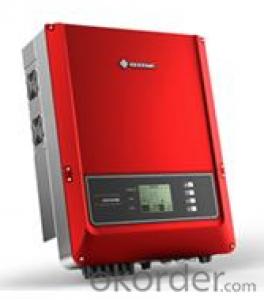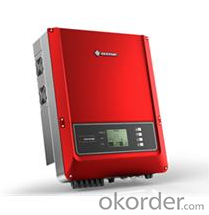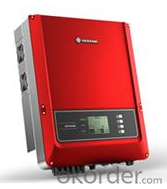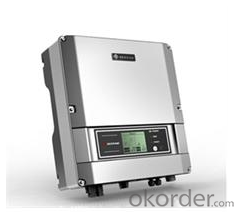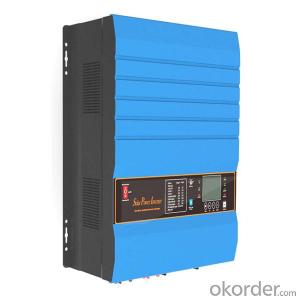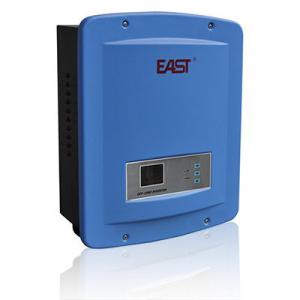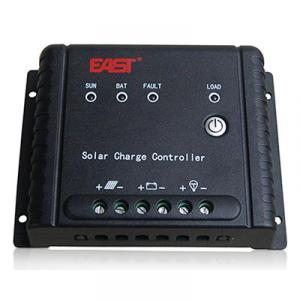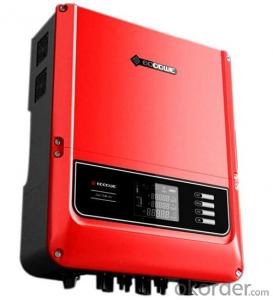220 Solar Inverter GW17K-DT On Grid Solar Inverter
- Loading Port:
- Shanghai
- Payment Terms:
- TT OR LC
- Min Order Qty:
- 10 unit
- Supply Capability:
- 100 unit/month
OKorder Service Pledge
OKorder Financial Service
You Might Also Like
GW17K-DT
GW17K-DT photovoltaic inverter is suitable for commercial and industrial roofs as well as small and medium-sized photovoltaic power systems. The optimized inductor design ensures less noise and higher European efficiency. The reliable grid support capabilities, high waterproof and dustproof grade and extra-wide voltage access range of components not only can be used in commercial roof and commercial power station systems, but also is qualified for the design requirements of large-megawatt power station.
| DC Input Data | Max.PV-generator power[W] | 17500 |
| Max.DC voltage[V] | 1000 | |
| MPPT voltage range[V] | 500~800 | |
| Turn on DC voltage[V] | 250 | |
Max.DC work current[A] | 22/22 | |
| Number of inputs/MPP trackers | 6/2 | |
| DC connector | SUNCLIX,MC IV (optional) | |
| Standby power consumption [W] | 10 | |
| AC Output Data | Nominal AC power[W] | 17000 |
| Max.AC power[W] | 17000 | |
| Max.output current[A] | 25 | |
| Nominal output voltage range | VDE-AR-N4105,VDE0126-1-1/A1,RD1699,G59/2,AS4777.2/.3 | |
| AC grid frequency | VDE-AR-N4105,VDE0126-1-1/A1,RD1699,G59/2,AS4777.2/.3 | |
| THDi | <1.5%< td=""> | |
| Power factor | 0.90 leading...0.90 lagging | |
| AC connection | 3W/N/PE,230/400V | |
| Efficiency | Max.efficiency | 98.2% |
| European efficiency | 97.5% | |
| MPPT adaptation efficiency | >99.5% | |
| Safty Equipment | Leakage current monitoring unit | Integrated |
| DC switch disconnector | Optional | |
| Islanding protection | AFD | |
| Grid monitoring | VDE-AR-N4105,VDE0126-1-1/A1,RD1699,G59/2,AS4777.2/.3 | |
| Normative Reference | EMC compliance | EN 61000-6-1 , EN61000-6-2, EN 61000-6-3, EN 61000-6-4 |
| Safety compliance | IEC 62109-1, AS3100 | |
| General Data | Dimensions(W*H*D) [mm] | 516*650*203 |
| Net weight [kg] | 39 | |
| Housing | For outdoor and indoor | |
| Mounting information | Wall mounting | |
| Operating temperature range | -20~60℃(up 45℃ derating) | |
| Relative humidity | 0 ~ 95% | |
| Site altitude[m] | 2000 | |
| IP proection class | IP65 | |
| Topology | Transformerless | |
| Cooling | Fan Cooling | |
| Noise level[dB] | <45< td=""> | |
| Display | 5"LCD | |
| Communication | USB2.0;RS485/Wi-Fi/ZigBee(optional) | |
| Standard warranty[years] | 5/10/15/20/25(optional) |
- Q: How does a solar inverter handle varying solar irradiance levels?
- A solar inverter handles varying solar irradiance levels by continuously monitoring the incoming solar energy and adjusting its operations accordingly. It converts the direct current (DC) produced by solar panels into alternating current (AC) that can be used to power electrical devices. When the solar irradiance levels are high, the inverter optimizes the power output to match the maximum potential of the solar panels. Conversely, during low solar irradiance, the inverter adjusts its operations to ensure optimal efficiency and power generation. This adaptive nature of solar inverters allows them to efficiently harness solar energy under varying conditions.
- Q: How does a solar inverter impact the payback period of a solar system?
- A solar inverter plays a crucial role in the payback period of a solar system. It converts the direct current (DC) electricity generated by solar panels into alternating current (AC) electricity that is usable for homes or businesses. A high-quality solar inverter ensures maximum energy efficiency, allowing the solar system to generate and utilize more electricity effectively. By optimizing energy production, a solar inverter can significantly reduce the payback period of a solar system, allowing users to recoup their initial investment and start saving on electricity bills more quickly.
- Q: How does a solar inverter handle voltage dips or fluctuations in the grid?
- A solar inverter handles voltage dips or fluctuations in the grid by constantly monitoring the grid voltage. When it detects a dip or fluctuation, it adjusts its own output voltage accordingly to maintain a stable and consistent power supply. This helps protect connected devices from potential damage and ensures that the solar system continues to operate efficiently.
- Q: Can a solar inverter be used with a solar-powered backup generator?
- Yes, a solar inverter can be used with a solar-powered backup generator. The solar inverter is responsible for converting the direct current (DC) generated by the solar panels into alternating current (AC) that can be used to power household appliances and electrical devices. When connected to a solar-powered backup generator, the solar inverter can efficiently regulate and distribute the electricity produced by the generator, providing a reliable and sustainable source of power.
- Q: Can a solar inverter be used with different monitoring platforms?
- Yes, a solar inverter can be used with different monitoring platforms as long as the monitoring platforms are compatible with the inverter's communication protocols and data formats.
- Q: What is the power factor correction capability of a solar inverter?
- The power factor correction capability of a solar inverter refers to its ability to adjust the power factor of the electricity it produces. A power factor is a ratio that measures the efficiency of electrical power usage, with a value between 0 and 1. A solar inverter with good power factor correction capability can optimize the power factor towards unity (1), which indicates maximum efficiency. This helps in minimizing reactive power and reducing energy wastage, resulting in a more efficient and effective utilization of solar power.
- Q: Can a solar inverter be used in systems with different module voltages?
- Yes, a solar inverter can be used in systems with different module voltages. Solar inverters are designed to convert the direct current (DC) generated by solar panels into alternating current (AC) that can be used in the electrical grid or for powering appliances. They are equipped with maximum power point tracking (MPPT) technology, which allows them to adjust and optimize the voltage and current output to match the specific voltage requirements of the solar panels. This flexibility enables solar inverters to work efficiently with various module voltages, making them compatible with different solar system configurations.
- Q: Can a solar inverter be connected to a battery backup system?
- Yes, a solar inverter can be connected to a battery backup system. In fact, this connection is essential for storing excess solar energy generated during the day and using it during times when the sun is not shining, such as at night or during power outages. The battery backup system allows for uninterrupted power supply and greater energy independence.
- Q: How does the input voltage range affect the performance of a solar inverter?
- The input voltage range directly affects the performance of a solar inverter. A wider input voltage range allows the inverter to accommodate a greater variety of solar panel configurations and fluctuations in solar energy production. This flexibility ensures optimal operation and increased energy conversion efficiency, resulting in better overall performance. On the other hand, a narrow input voltage range restricts the inverter's compatibility and may lead to reduced efficiency and output power.
- Q: Can a solar inverter be used with different types of solar panel mounting systems?
- Yes, a solar inverter can be used with different types of solar panel mounting systems. The solar inverter is responsible for converting the direct current (DC) generated by the solar panels into alternating current (AC) that can be used to power electrical devices. The mounting system, on the other hand, is used to securely install the solar panels in various locations such as rooftops, ground mounts, or pole mounts. As long as the solar panels are compatible with the inverter's specifications and the mounting system is properly installed, the solar inverter can be used with different types of solar panel mounting systems.
Send your message to us
220 Solar Inverter GW17K-DT On Grid Solar Inverter
- Loading Port:
- Shanghai
- Payment Terms:
- TT OR LC
- Min Order Qty:
- 10 unit
- Supply Capability:
- 100 unit/month
OKorder Service Pledge
OKorder Financial Service
Similar products
Hot products
Hot Searches
Related keywords

